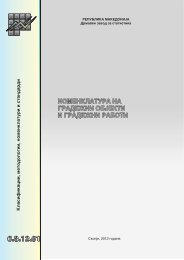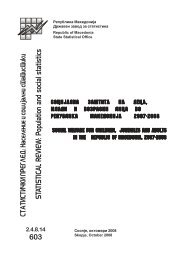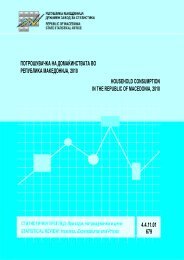586 potro[uva^ka na doma]instvata vo republika makedonija, 2007 ...
586 potro[uva^ka na doma]instvata vo republika makedonija, 2007 ...
586 potro[uva^ka na doma]instvata vo republika makedonija, 2007 ...
Create successful ePaper yourself
Turn your PDF publications into a flip-book with our unique Google optimized e-Paper software.
METHODOLOGICAL EXPLANATION<br />
The Data Sources<br />
The data presented in this Review have been obtained on the basis of the statistical survey known as the "Household<br />
Consumption Survey", conducted during <strong>2007</strong>.<br />
An observation unit is each household for a single-person or a household comprising more members that has<br />
been selected according to the sample plan.<br />
The term "household" is defined as:<br />
- each single person who lives on his own and does not have any other household in some other place;<br />
- family or any other community of people who live and spend their incomes together in order to cover their basic<br />
costs (those for living, food and so on) regardless of whether all the members of the household are continually present<br />
in the place of residence or whether some of them are staying for a longer time in other place or country for purposes of<br />
education or employment.<br />
Persons who are not members of the family, in case they work, eat and reside in the same house community<br />
(house-maid, permanent workers on private agricultural holding and so on) are classified as household members.<br />
Pupils and students are considered to be household members irrespective of how much time they spent outside<br />
the household (at schools and studying).<br />
Territorial Range<br />
The survey is carried out on the whole territory of the Republic of Macedonia.<br />
Sample<br />
The survey is conducted on sample of 5040 households on the whole territory of the country, which is about 1%<br />
of the total number of households in the country.<br />
The frame of the selection are all enumeration districts that contain above 20 households, from Census 2002.<br />
The sample is two-stage stratified. Primary sampling units are the enumeration districts and secondary sampling<br />
units are the adresses of households.<br />
For the needs of the sample stratification on two levels with the total 16 strata was made:<br />
- Eight geographical regions, NUTS 3 and<br />
- Two contingents- urban and rural areas.<br />
In the sample were 210 enumeration districts. The allocation of the sample in the stratas for the first stage is<br />
proportio<strong>na</strong>lly to the number of households in the region, and in the second stage for each selected enumeration district<br />
each quarter 6 households were selected randomly with equal probability. Each quarter were interviewed 1260 households,<br />
or 5040 different households on annual level.<br />
In the survey are not allowed substitutions of the households.<br />
ESTIMATES AND ERRORS CALCULATION<br />
The estimates in the Households Budget Survey are in the forms of totals and ratios.<br />
The <strong>doma</strong>in of estimates is whole country.<br />
In the estimating procedure of HBS- <strong>2007</strong> year the non-response adjustment has been made on the level of<br />
enumeration districts. The errors are calculated as relative errors. All errors calculations were made with statistical<br />
package SAS.<br />
The non-response rate for HBS-<strong>2007</strong> was 13.4 % and the refusal rate was 9.4%<br />
TOTAL<br />
rates in % all urban rural<br />
non-response 13.4 16.7 8.1<br />
refusal 9.4 11.8 5.6<br />
The Survey Method<br />
In the Survey, are used two the methods: method of carry out of diaries and method of interview on the basis of<br />
question<strong>na</strong>ire forms. In the Survey, data for incomes are collected for three months, while data for expenditures are<br />
collected for 15 days, during which each household make records for expenditures in the diary.<br />
The Household Socio-Economic Category<br />
The categorization of the households into one of the three possible categories is done on the bases of the<br />
following criteria:<br />
An agricultural household is a household with its own agricultural holding and all its members able to work are<br />
engaged on the holding as agricultural workers. None of the household members is officially employed outside the<br />
holding, none of them owns a store for trade and none of them is a pensioner, but one or more of its members can<br />
occasio<strong>na</strong>lly work outside the holding in order to earn some additio<strong>na</strong>l incomes.<br />
8 Statisti~ki pregled 4.4.8.01/<strong>586</strong>


![586 potro[uva^ka na doma]instvata vo republika makedonija, 2007 ...](https://img.yumpu.com/15551548/8/500x640/586-potrouvaka-na-domainstvata-vo-republika-makedonija-2007-.jpg)


